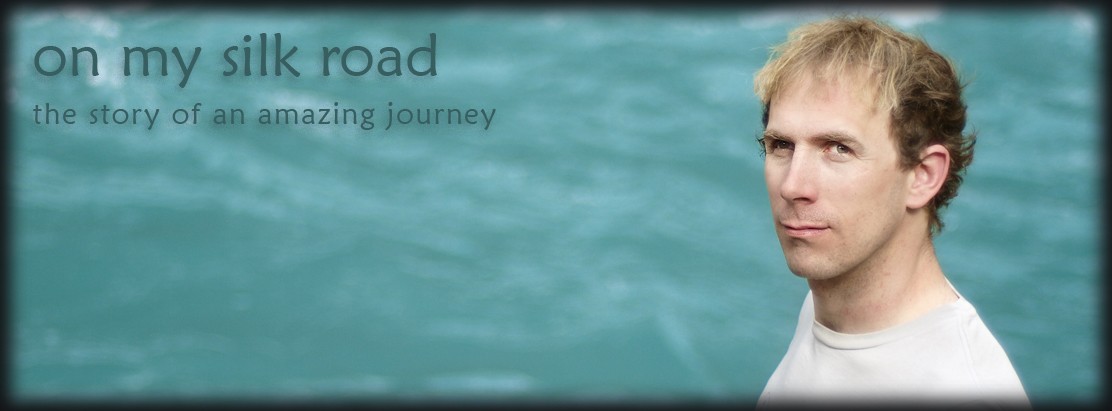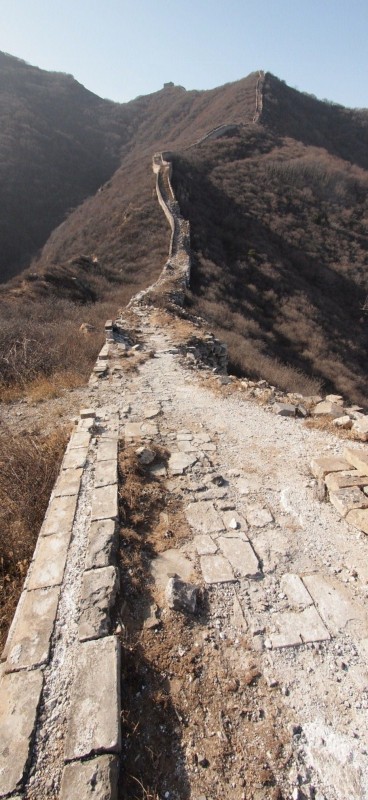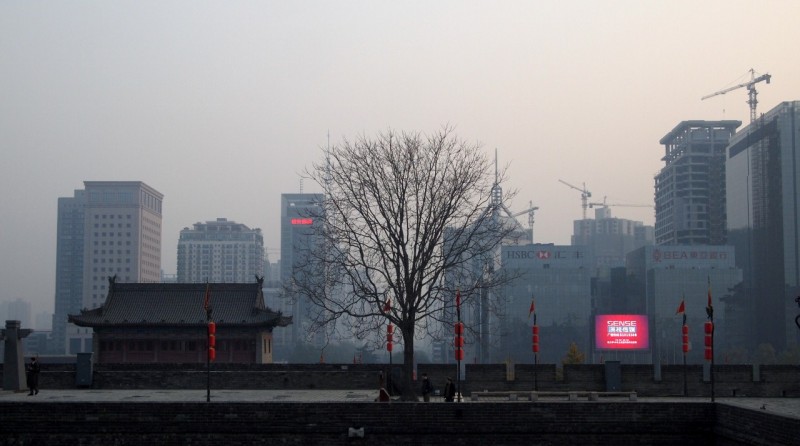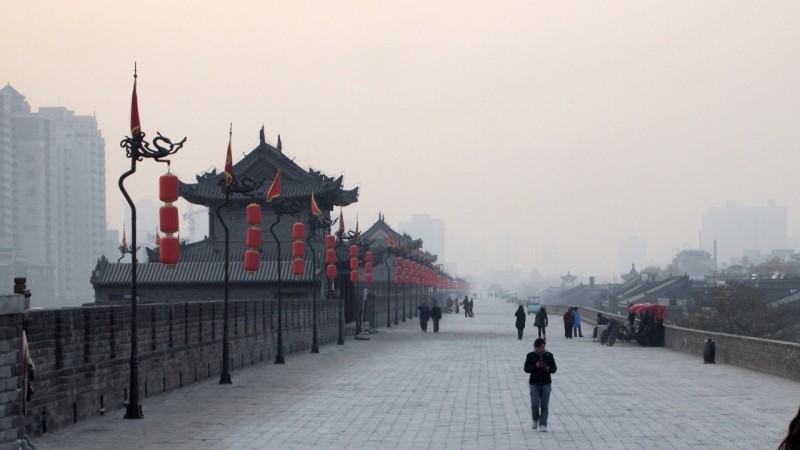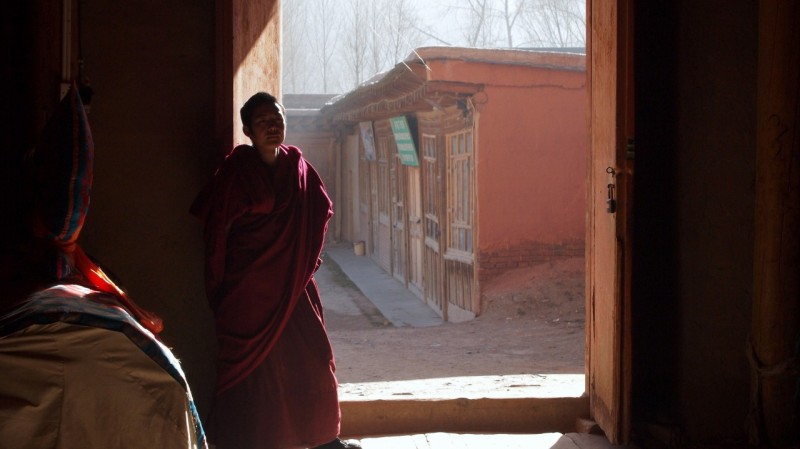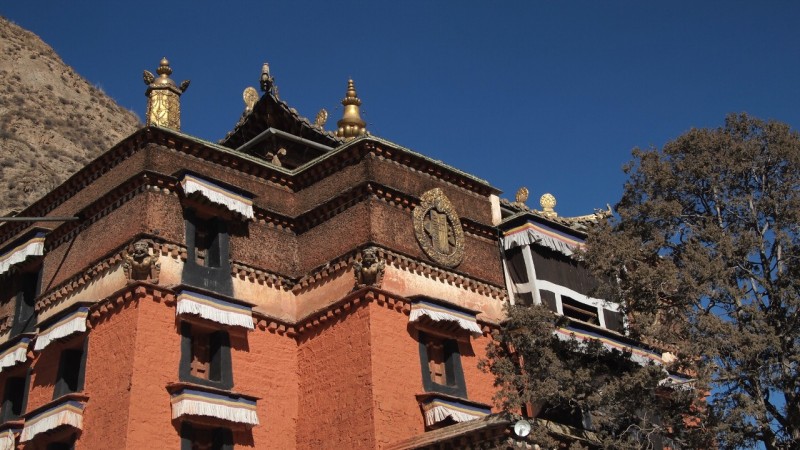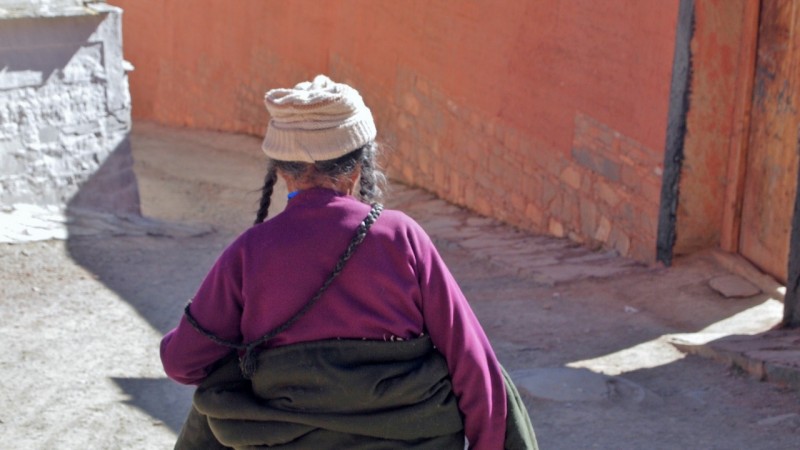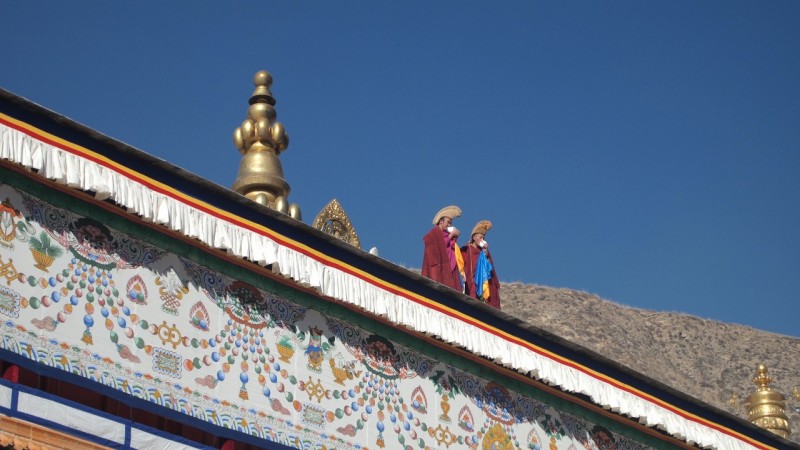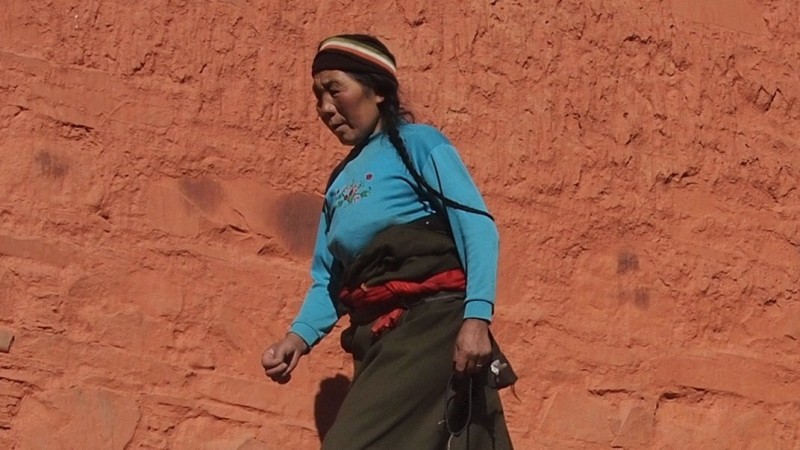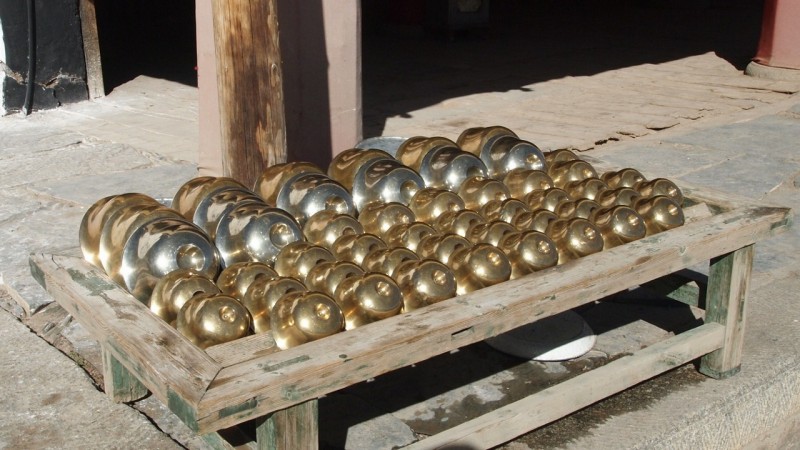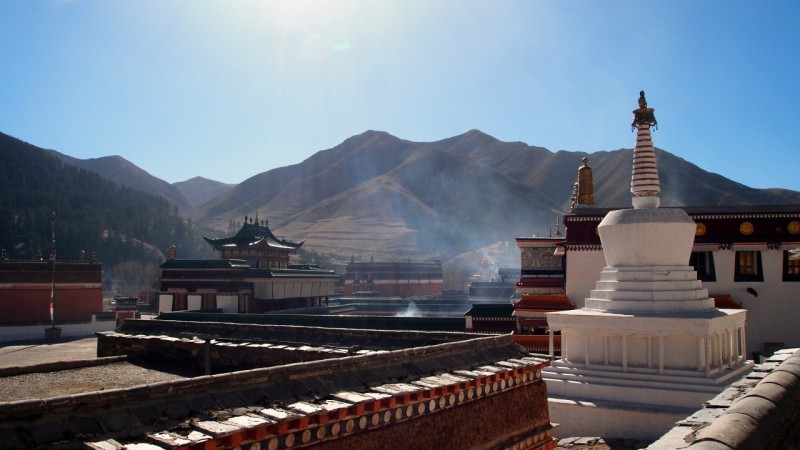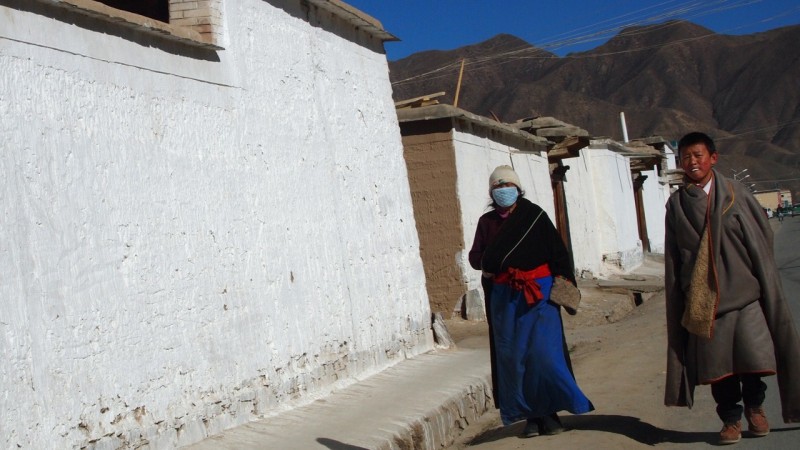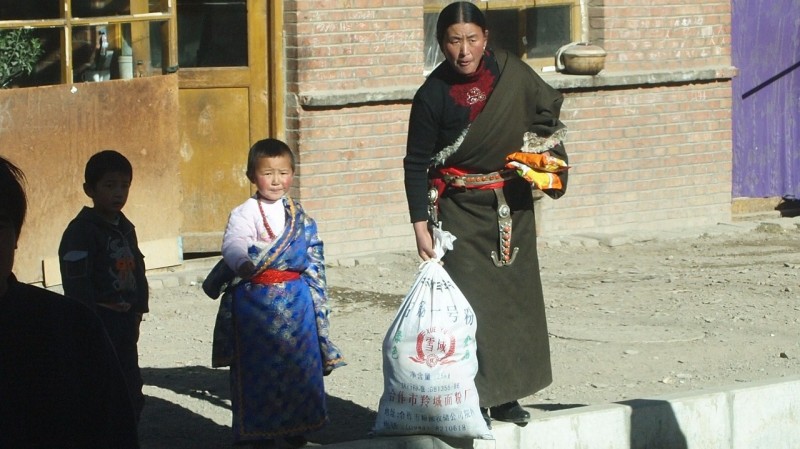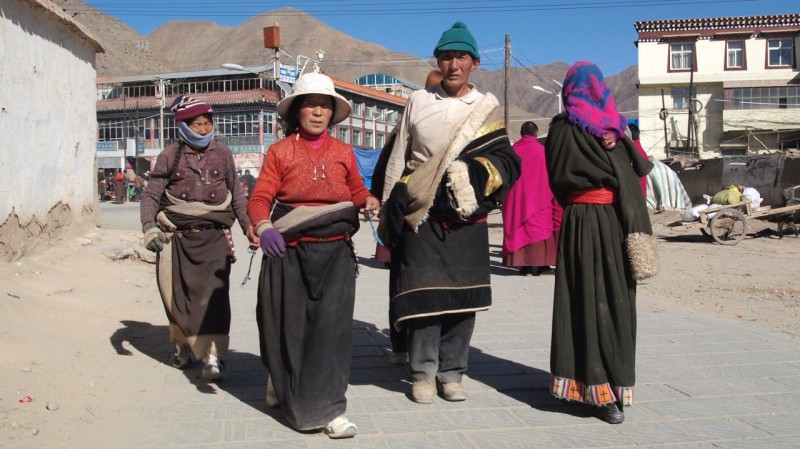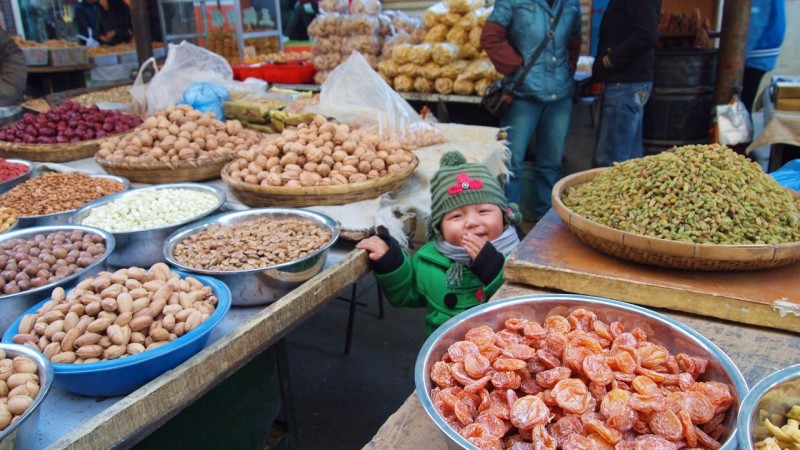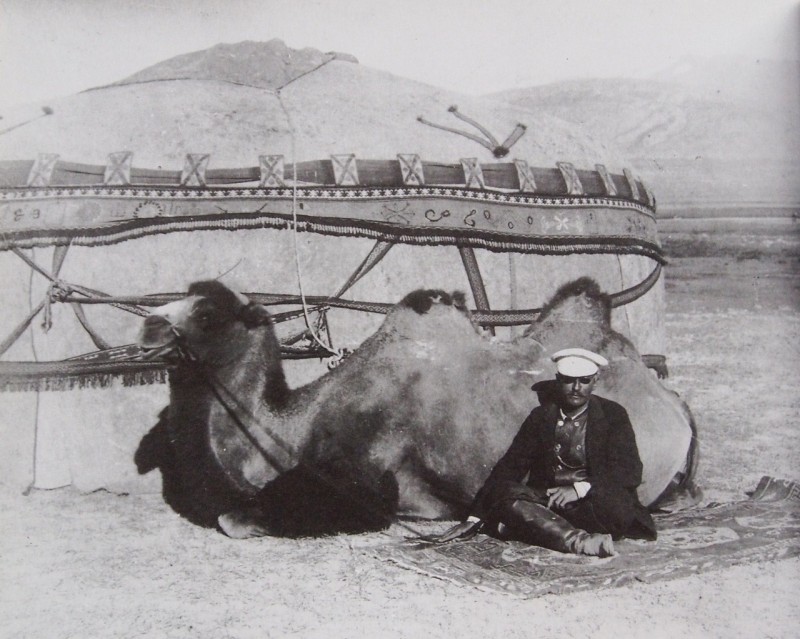Threatening for travellers, locals and further people. “You’ll go and won’t come back”, “go in and you will never come out”, this is what Taklamakan means in local Uygur language. It’s one of the most arid deserts, and for the caravans of the silk road, a nightmare place. It was impossible to cross, a certain death, so it was surrounded. The north route passes by the Tien Shan mountains. The south borders the Kulum mountains that became Tibet later.
In case this was not enough on the west it’s flanked by the Pamir mountains and on the east there are the Gobi and Lop Nor deserts. Taklamakan itself is surrounded by the highest mountain ranges in the world and by two more deserts nearly as hard as itself. Doing it on purpose would not be that hostile, a natural trap.

The first place I visit after Kashgar is Yarkland. Here I go to the Altyn mosque. It’s quite like the Uzbek mosques with elaborated wooden columns, however they are painted in colours here. One of the facades is open to a courtyard.
In the Altyn mosque you can get in without problems but walking by the old quarters I got into a small mosque and the “keeper” told me get out in quite an unpleasant way. As far as I know there is no church where non believers can’t get in. If you are respectful and discrete I don’t think you annoy anyone.

There was a nearby Muslim cemetery. A man cleans in the silence.

What a better place to have a nap that between the dust and the sun?
This is the southwest of Taklamakan desert. Until the X century here there were Buddhist believers and an Iranian language was spoken. Later the Turks came and brought Islam.
Yarkland was important in the silk road because from here there was a crossing to Leh in India. Today it is a small city but as any other Chinese city, even the smallest dot in the map is bigger than what you would imagine.
From here I go to Khotan. I cross the city of Karguilik that is where the expeditions to the Chinese part of K2 departs.
The bus leaves me at 11 p.m. in the station. I open the guide book and search the hotel I’ve chosen to stay. I don’t find it, neither the next one on that guidebook, neither the two first of the second guidebook… Am I in Khotan? I’ve been walking for an hour. Why can’t I have found four hotels? I said Khotan when I bought the ticket, right? The next hotel was there. It was called “Happy Hotel”, yes, I’m in Khotan. One a.m. how hungry!

In the restaurant I shared table and tea with this couple. In restaurants here you always have a teapot totally for you. We had not too much common language but they were very kind and pleasant, we had had some sleepy laughs and then; to bed.

Melikawat, the ancíent Khotan. An immensity, dusk, a 14 years old sheppard girl and some remains of ancient buildings that remind how big this city was. As the place is not very visited you can still find ceramic pieces on the ground.
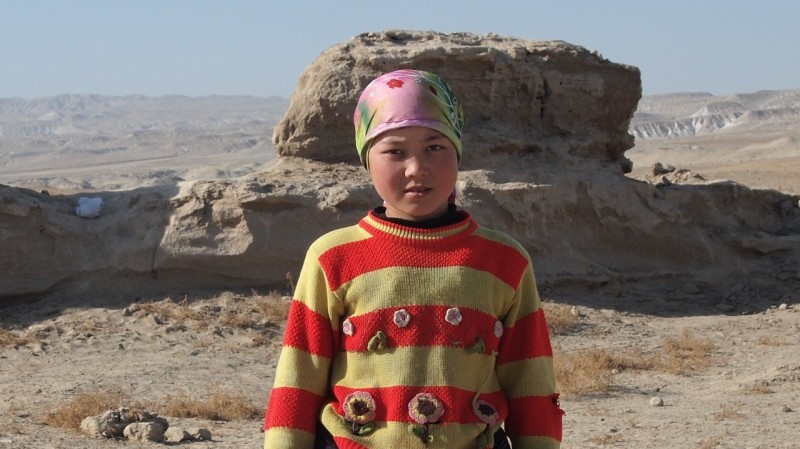
The shepard is not really aware of the history that her goats are pasturing around. If you haven’t read about the explorer that came here during the 19th and 20th century that came here to explore archaeological treasures it may just be another ruin.
Khotan is a synonym of Jade, even it was a stop on the silk road Khotan has been known for centuries for it’s jade from the rivers Karakash and Yurungkash, the rivers of black and white jade. In fact Khotan was in what was called the jade route. The city has hundreds (hundreds means hundreds) of jewellery shops and workshops working with Jade.
I want to buy a ball of jade as memory. Apart from hats I usually don’t buy anything but this is something I feel like buying. It takes me quite a while, but at the end I find a set of Chinese balls in black jade from the Karakash river. My backpack complains about the weight.
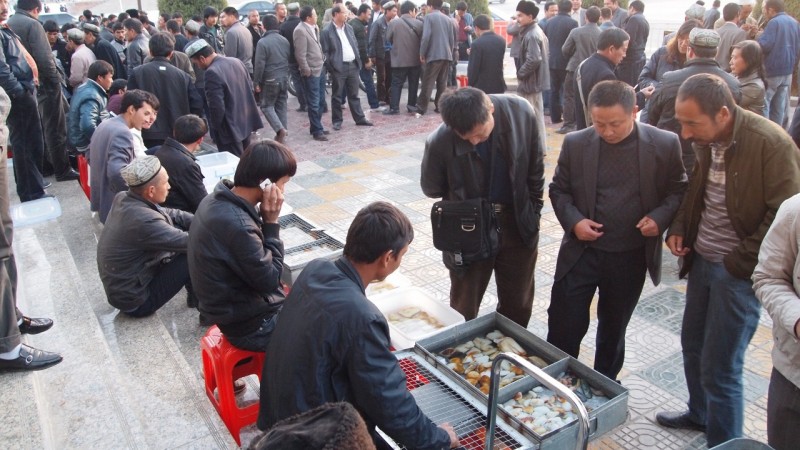
In the afternoon I saw a crowd in a corner of the center of the city. I go to see what it was. A pile of men were selling and buying jade stones. Seems that people go to the rivers to collect them and then they sell them here. They keep then in a container with water so they look better and you can see suited buyers looking at the stones with care and lighting them with a light to she their translucency so they pay the right price.
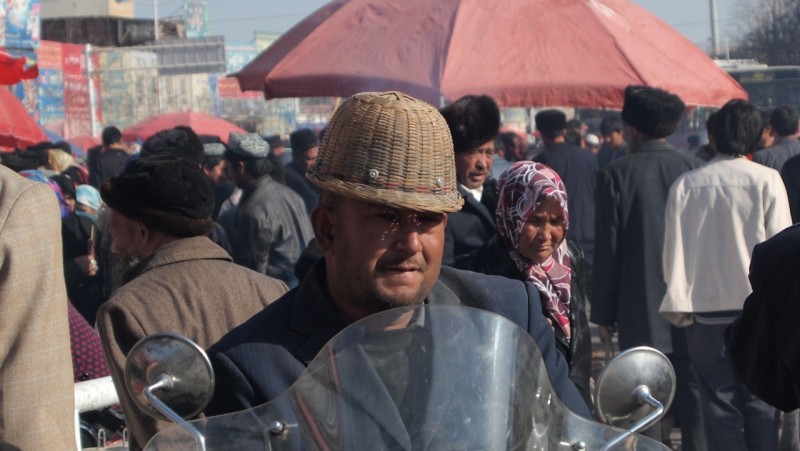
Is it homologated?

I get to the Sunday market. I see the amount of people by square meter, I buy two bananas and leave. It is as big as Kashgar market and I don’t want to be squashed by so many people.

Mummy of the local museum from about 1500 years ago.

It’s quite like the Pizza Hut logo, but it’s not.

More hats.

A han food restaurant.
It’s time to decide the route to choose. I can continue by the south route but sounds complex to move around but it attracts me, if it’s difficult to move around there won’t be too many people and that’s always attractive. On the other side there’s not much to see either and crossing to the north by the middle of Taklamakan desert sounds good too. If to me it’s difficult to decide I can’t imagine how difficult could it be to merchants to choose the north or south route. For me at the end is no more than getting a bus with one name or another.
I felt like crossing the desert, but the bus does part of the journey at night and at night you don’t get to see the landscape. Finally I decided that even I don’t see the 10 hours of desert it’s ok, I calculated that I’d do four hours of desert and that would be enough. But the south route also has interesting things. What should I do?!

The last trees I see in hours.
After changing my mind 20 times by hour I decided to get the bus to cross the desert in the longest bus journey of my life. I don’t know yet I I’ve taken the express bus of 20 hours or the normal that is 25 and I already have the ticket! There are things that are impossible to find out.
I go by a unique road. 552 kilometres of asphalt crosses the desert. On the sides I see buildings with numbers, the first one I see has 80, they are wells to water the brushes that have been planted on the sides of the road to avoid the sand getting over the asphalt.
Never a road like that had been built in moving sand dunes but the petrol found here has done what during years seemed impossible, crossing the desert. And the most impossible even, crossing in just a few hours. Even the prodigious of the road it’s still a desert and the bad weather can close the road for days.
The bus has very reclined seats more like beds and I lean looking by the window. It’s possible to sleep very well so the journey doesn’t seem that long.
I have a very kind “protector” today. He never stops smiling and his smile seems not to fit totally in his face. He invites me for lunch when I ask how long is the stop and every time I look to the back I meet his smile.
He’s travelling to Urumqi with his wife. She doesn’t wear burka, but behind the scarf I can only see her eyes. They don’t stop talking all the trip and he’s sitting on the aisle to be closer to her, they talk in the afternoon, all night and in the morning, they laugh a lot and share thousands of things. You can see they are happy together.

The desert is surrounded by oasis-cities, small villages, hundreds of greenhouses and a lot of crops that you see on the sides of the road. On the divert to the desert towards the inside of the desert there were still some trees but shortly later there would be only sand dunes.

I get to the front part to get a picture, the drivers take a cushion to me and invites me to have a seat on the stairs so I’m more comfortable and I can take pictures, also that way we can chat a bit. Chat in this case means communicate, we don’t have many words in common, but we have 16 hours to try.
When the driver that drives got some confidence to ask me for the sun glasses. I think he’d seen me in on of the stops and wanted to try them on. He likes them, want’s to swap for his glasses, but I’d tell him no because my eyes are weak and I need covering glasses to protect them. He doesn’t care much about that and insists on keeping them so I tell him I’ll swap my shades for the bus. Now I have transport to go to Xian, hope it does not use too much petrol.
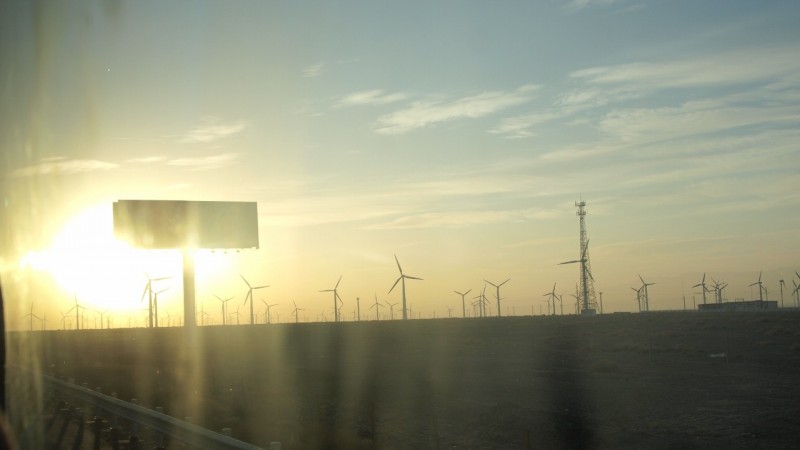
It’s sunset and I see windmills by the window. The last time I saw some was in the east of Iran.
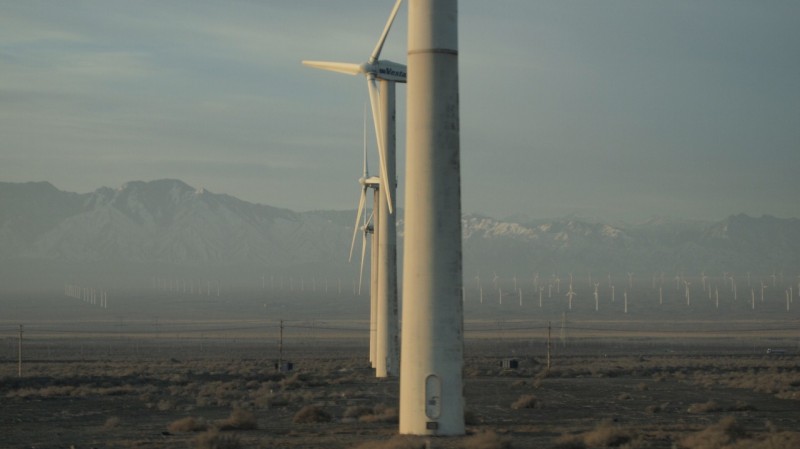
There are hundreds.
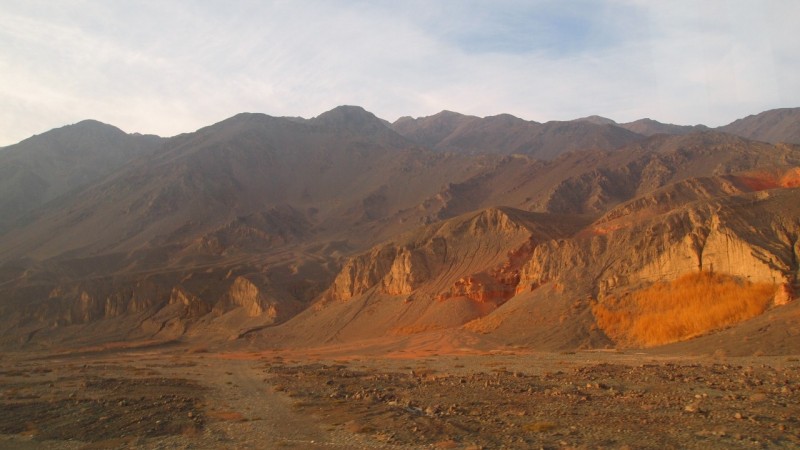
It´s very arid.
When we arrive to Urumqi I decide to get another 2 hours bus to Turpan making it a total of 25 hours.
I arrive to Turpan. This city is in the northeast of the desert of Taklamakan. In ancient times it was an oasis that brought the water from to mountains by a Karez, a subterranean water collecting system to bring it to the village. In Iran I told you about this, they call it Qanar there but it’s the same technology.
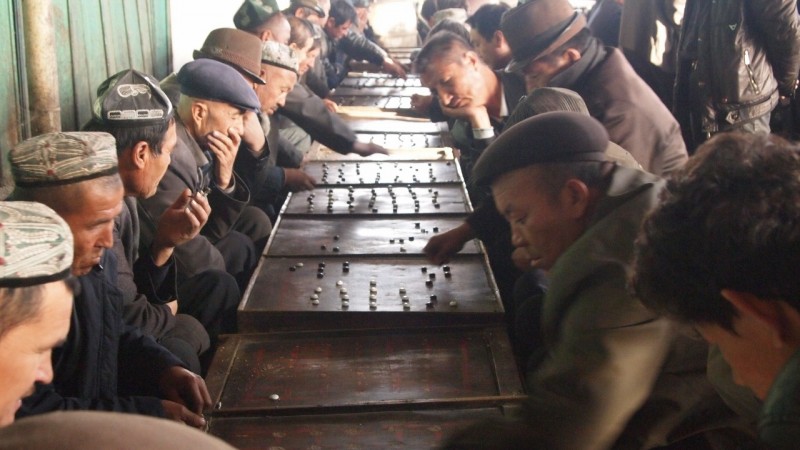
Playing Chinese chess near the market.

Is he thinking or bored?
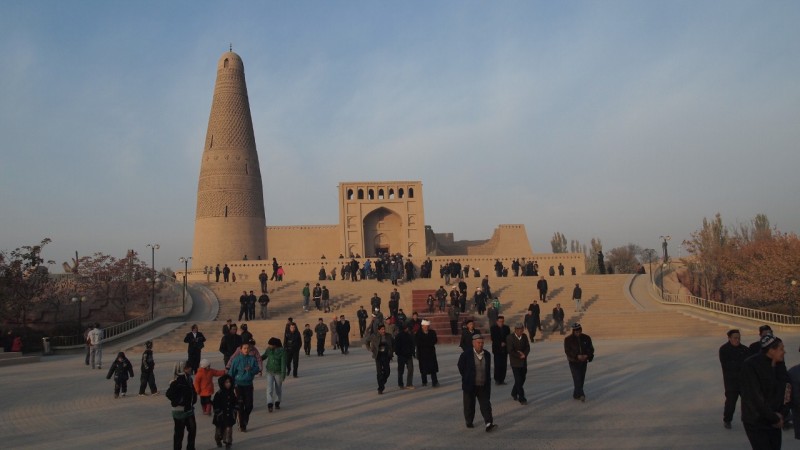
I go to the Emin mosque. The rounded style of the minaret and the thick base are new for my minaret collection, it’s Afghan style, from 1777.

Today is a special festivity, it’s seven in the morning and the faithful have gathered to pray. It’s exciting, you are never allowed to get into a mosque in praying time. People lean once in a while, they look to the sides often and murmur prayers when it’s time to do it. Looks quite like a mosh.
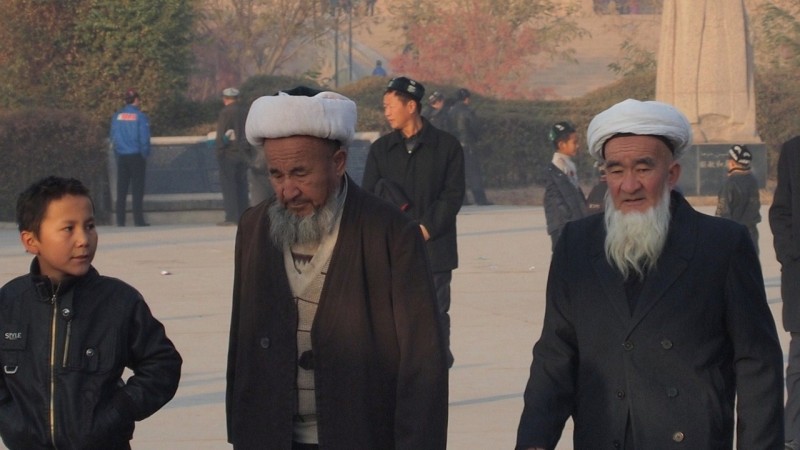
After praying they all go home, it’s the tradition. A goat is killed and cooked with the family.

Near Turpan the Jiaohe ruins are found, they are quite destroyed so I season the picture with a modern Chinese.

The signs are a bit deficient, aren’t they? “Two minutes to the big temple”. Even though it’s very interesting and it’s UNESCO world heritage.

Another stop on the small village of Toyugou, it’s not very touristy and very authentic, ideal to finish the day with afternoon sun.
In the Turpan hotel I’ve got a lot of luck, I’ve got together with a couple, an American girl and a French guy, they’ve been living in Shangai for three years and apart from been super nice they talk good Chinese and are my translators all day. I’m happy. They know all the food and they tell me tons of things I would have never realize about by myself. I can’t be better.

Turpan area is in the second lowest depression after the dead sea with -154 meters under the sea level.

I don’t know why these beds are on the hill, but as the image is peculiar I put it here.
With this I’m about to finish my journey in the Taklamakan desert, a name that has resounded in my head during a few years until I’ve seen it. For you it may be a new name, but I’m sure it’s one of those names that once you know them you start hearing them in the telly and see it on magazines once in a while and you’ll think it’s impossible you haven’t know it before.
The driver that has taken us around all day tells me that in two hours there’s a night bus to Dunhuna, my next stop. JP and Marian have the same destination, they were thinking on going tomorrow but they change their plan.
I buy something in the market while they pack their bags and we get into the bus towards Dunhuang to see the Caves of the the Thousand Buddhas. After all day from one place to another I fall asleep immediately.
Zzzzzzzzzzzzzzzzzzzzzzzzzzzzzzzzzz
Shhhhhhh[Fernando]

 I guess this is what happened to Way Away people. After doing a big seems you become instantly in a world tourism guru. It doesn’t matter where your friends OR the people that sees your website is gong, everybody asks you what to do, how to by the tickets OR where to sleep. But I have not been to Argentina yet!!!!! Does not matter, they ask you any way.
I guess this is what happened to Way Away people. After doing a big seems you become instantly in a world tourism guru. It doesn’t matter where your friends OR the people that sees your website is gong, everybody asks you what to do, how to by the tickets OR where to sleep. But I have not been to Argentina yet!!!!! Does not matter, they ask you any way.